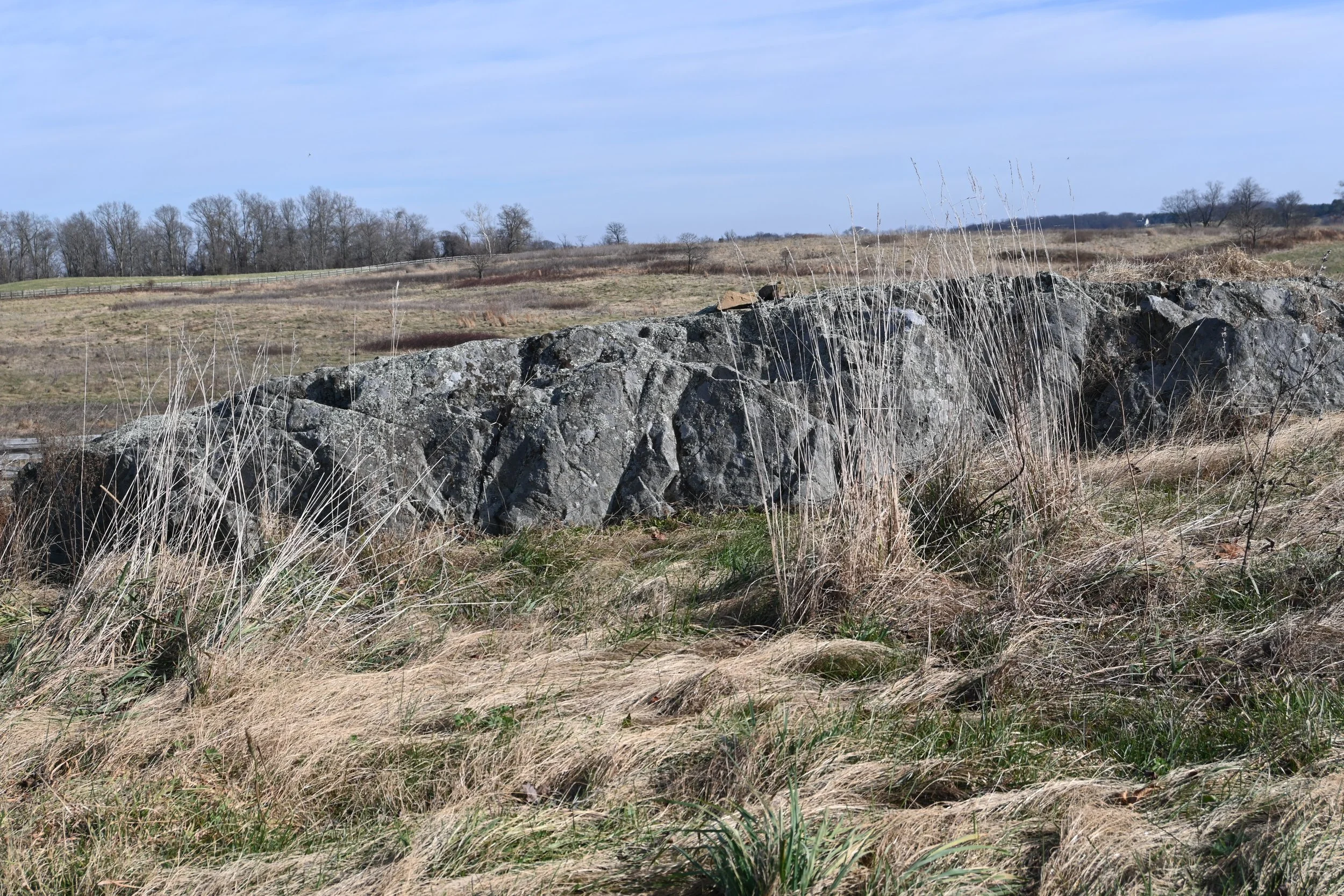Boulders into Sand
OSGF
Soil is the source for all of our daily needs. From it we have fibers to clothe us, food to feed us, and materials to shelter us. It provides our drinking water and acts as a natural buffer, purifying our groundwater. Healthy soils also can contain an entire world teeming with fungi, arthropods, bacteria, and other microbes which help us not only sustain life, but improve our overall physical and mental health. It’s said that it takes between 500 and 1,000 years for one inch of topsoil to form, which makes soils a precious resource. In recognition of World Soils Day, read below to learn more about the native soils of Oak Spring Garden Foundation and how healthy soils contribute to the health of our planet.
To talk about soils, we first need to look at geologic formations and the broader timeline of Earth's history. Every rock in our landscape was formed progressively through a process of unique conditions. Stretching far, far back in geologic time (some 4.5 BYA), when the Earth was just forming, its surface was a shifting landscape of molten magma which eventually began to cool, forming the first faults on the planet. Once broken up, these faults shifted under and onto each other by the first subduction zones. While the precise origins of the first zones, or what caused the initial lithosphere to break apart is still widely unsolved, we do know that the fragments’ movement is responsible for the mountains, seas, and landscapes we have today.
Similarly, Virginia’s geologic history was dictated by the continental and oceanic plates shifting across the Earth’s crust millions of years ago. Today the result is a complex geologic mosaic of different physiographic regions across the state including: Coastal Plain, Piedmont, Blue Ridge, Valleys and Ridges, and small slivers of the Appalachian Plateau. Oak Spring sits in the Piedmont plateau and neighbors the Blue Ridge province. The western portion of the Piedmont has formations dominated mainly by granite and granitic gneiss, indicative of the Marshall Formation, which was formed some 1.5 BYA during the Proterozoic Period.
Map courtesy of Virginia DCR, Division of Natural Heritage.
When it comes to soils, the local geologic formations and climactic events are imperative to understand as soils are derived from the breakdown of these rock formations over millennia. Granite, gneiss, schist, mica, quartz and feldspar are all predominant parent material of the Piedmont formation. From these parent materials, the soils that were produced were by and large poor in nutrients. Larger igneous and metamorphic parent material contributed greater calcium and magnesium levels, which somewhat helped the soil's viability for agricultural use. For us here at Oak Spring and the wider Fauquier County, there are three predominant soil types:
Greenstone
Gneiss
Alluvium
Image of Biocultural Conservation Farm, courtesy of BCCF team.
As every farmer knows, understanding the soil type is necessary for a successful farming operation. Our team at the Biocultural Conservation Farm are no strangers to this either. Regenerative agriculture is one of the key practices implemented at the farm, which actively works to create healthy soils. In maintaining high soil biodiversity, agricultural lands, which have largely been degraded due to conventional farming practices, can be improved and contribute to the health of the broader ecology. A healthy soil with a high content of microorganisms produces greater yields, minimizes runoff, and makes farms more resilient to the impacts of climate change. This idea is of course nothing new; Indigenous peoples were working in tandem with the land, farming its resources in a sustainable way long before European colonization.
The main outcome of regenerative agriculture is the sequestration of carbon. In our time of the Anthropocene, as atmospheric carbon continues to rise and cities around the globe are already experiencing the effects of climate change, the systems that are capable of sequestering carbon have become more important than ever. The carbon cycle is a natural process that results in carbon storage in the ocean, land and vegetation. According to the Ecological Society of America, soils hold around three times as much carbon than living plants and animals. Practices like low-till, which reduces soil disturbance, cover cropping, crop rotation, and the addition of compost all contribute to an increase in the soil’s organic carbon content while storing atmospheric carbon. In 2020, visiting professors and students from Skidmore College visited Oak Spring to conduct an initial soil sampling to determine the carbon content, which can be viewed here.
If you’re interested in learning more about the soils in your county, visit the USDA’s Web Soil Survey: https://websoilsurvey.sc.egov.usda.gov/App/HomePage.htm
Sources:
Fichter, Lynn S, and Steve J Baedke. “Geological Evolution of Virginia and the Mid-Atlantic Region.” James Madison University, 1999, https://csmgeo.csm.jmu.edu/geollab/vageol/vahist/index.html.
Gaige, Michael. An Oak Spring Landscape: History, Ecology, and Management at the Oak Spring Garden Foundation. OSGF, 2018.
Hammer, Allison. “Geology of Virginia.” ArcGIS StoryMaps, Esri, 25 Mar. 2021, https://storymaps.arcgis.com/stories/e4b218c6dc404786b734c281693e9bfd.
Sawyer, James H. “Interpretive Guide to the Type 1 Soils of Fauquier County, VA.” Fauquier County, VA, Department of Community Development County Soil Scientist Office, 2008, https://www.fauquiercounty.gov/home/showpublisheddocument/7822/635936417768800000.
USDA. “Soil Health Literature Summary—Effects of Conservation Practices on ...” USDA Natural Resources Conservation Service National Soil Survey Center , USDA, 2015, https://www.nrcs.usda.gov/sites/default/files/2022-10/Soil_Health_Literature_Summary_Effects_of_Conservation_Practices_Jan2015.pdf.
USGS. “Geologic Units in Virginia” Interactive Maps and Downloadable Data for Regional and Global Geology, Geochemistry, Geophysics, and Mineral Resources; Products of the USGS Mineral Resources Program, USGS, https://mrdata.usgs.gov/geology/state/fips-unit.php?state=VA.
Virginia Dept. of Conservation and Recreation. “The Natural Communities of Virginia Classification of Ecological Groups and Community Types.” Natural Communities of Virginia, Virginia DCR Natural Heritage Program, 2021, https://www.dcr.virginia.gov/natural-heritage/natural-communities/.
Special thanks to Geologist Holly Theobald for help with this blogpost.

